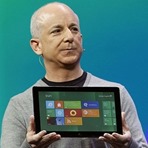 Tonight’s bombshell of an announcement that Microsoft Windows Division President is out, effective immediately has, of course, fueled lots of speculation, centered around whether Steven Sinofsky left of his own accord, or was pushed out the door.
Tonight’s bombshell of an announcement that Microsoft Windows Division President is out, effective immediately has, of course, fueled lots of speculation, centered around whether Steven Sinofsky left of his own accord, or was pushed out the door.
In the latest piece of news, Paul Thurrott has posted Sinofsky’s letter to “All Employees”, and in it Sinofsky paints a picture where the whole sudden departure was his idea alone. In fact, he says:
Some might notice a bit of chatter speculating about this decision or timing. I can assure you that none could be true as this was a personal and private choice that in no way reflects any speculation or theories one might read—about me, opportunity, the company or its leadership.
As I’ve always believed in making space for new leaders as quickly as possible, this announcement is effective immediately and I will assist however needed with the transition.
I am super excited for what the future holds for the team and Microsoft.
And yet, according to the Wall Street Journal’s All Things D blog, at least, it wasn’t totally one-sided:
Officially, Microsoft is saying that the move was a mutual decision by Sinofsky and the company.
For the record, the press releasesays nothing about any “mutual decision”, only saying that Sinofsky “will be leaving the company”.
All Things D made reference to what has been reported as “tension” between Sinofsky and not only Steve Ballmer, but the leaders of other divisions within the company:
Sources have said the move came amid growing tension between Sinofsky and other top executives. Sinofsky, though seen as highly talented, was viewed at the top levels as not the kind of team player that the company was looking for.
We reported earlier on Jay Greene’s post on Sinofsky, and tonight he has posted again, saying that his departure “shouldn’t surprise anyone”:
But Sinofsky may well have picked the wrong fight. His ability to ship quality products on time appears to have been trumped by the toxic environment he created. In last month’s profile, I quoted Charlie Kindel, a 21-year Microsoft veteran, who said Sinofsky made it harder for the Windows Phone division to work closely with the Windows group.
“It represents a siloed perspective,” Kindel said. “It represents an us versus them perspective.”
At the same time, many Microsoft employees have also expressed sadness at his announced departure, including Dare Obasanjo, numerous posters to Sinofsky’s Facebook page, and even some on a hastily posted Mini-Microsoft blog entry, which should provide some entertaining reading in the hours and days ahead.
Regardless of whose idea it was, or how it came about, the real questions will soon begin. Will Steve Ballmer be able to innovate with the company he is rebuilding before our eyes, with Skype and Yammer and Surface and a less-strong Windows? And who will fill the void left by such high profile departures such as Sinofsky, Ozzie, Muglia, and more? Will Julie Larson-Green become a rising star? What about Tony Bates, over in Skype? Will Microsoft “acqui-hire” new leadership? This is a big shake-up, and if nothing else, it’s going to be fun to watch.